The German Shepherd ranks among the top five most popular dog breeds in the United States. These incredible dogs show their excellence and versatility in the canine world. They started as sheep herders and now excel in police work, search and rescue, and service assistance. Their success in different working roles proves how adaptable they are.
German Shepherds are remarkable dogs that deserve a detailed look. In this piece, you’ll find everything about their distinctive traits, exercise needs, and health concerns. Experienced dog owners often choose German Shepherds because match their skill level. A well-socialized German Shepherd makes an excellent family dog. Before getting a puppy from a trusted breeder, think over the investment of $2,000-$4,000.
The German Shepherd Dog: At a glance
| Characteristic | Details |
| Height | Males: 24-26 inches (60-65 cm) Females: 22-24 inches (55-60 cm) |
| Weight | Males: 65-90 pounds Females: 50-70 pounds |
| Lifespan | 9-13 years |
| Coat Types | Double coat with: Dense, harsh outer layer, Soft undercoat |
| Common Colors | Black and tan, Red and black, Sable, Pure black, Pure white |
| Exercise Needs | High – Daily physical activity required |
| Intelligence Ranking | Third smartest dog breed |
| Shedding | Year-round with heavy seasonal shedding |
German Shepherds have a balanced build with smooth, graceful curves that flow naturally. The breed’s signature features include a broad head that tapers to a sharp muzzle, large erect ears, and a muscular back. Their bushy tail curves downward and complements their balanced look.
These athletic dogs can sprint up to 30 miles per hour. Their natural gait helps them cover ground with minimal steps, which shows their agility and stamina.
German Shepherds’ temperament combines several unique traits. They show deep loyalty and protective instincts yet maintain a slight distance that prevents quick friendships with strangers. These dogs bond strongly with their families and blend well with children and pets if socialized early.
The breed’s smarts and trainability make them exceptional. As the third-smartest dog breed, German Shepherds thrive in roles from police and military work to service and assistance duties. Their sharp minds and physical strength make them versatile working dogs.
Recent studies show 63.43% of German Shepherds develop at least one health issue during their lifetime. Common health problems include:
- Ear infections (7.89%)
- Arthritis/joint disease (5.54%)
- Digestive issues (5.24%)
- Weight management challenges (5.18%)
German Shepherds remain popular worldwide despite these health concerns. Registration numbers have shifted from 3.5% of all dogs in 2005 to 2.2% in 2013.
These dogs need regular grooming, particularly during their twice-yearly heavy shedding periods. Their double coat helps regulate body temperature throughout the year. Brushing several times weekly keeps shedding under control and maintains a healthy coat.
The History and Origin of German Shepherds
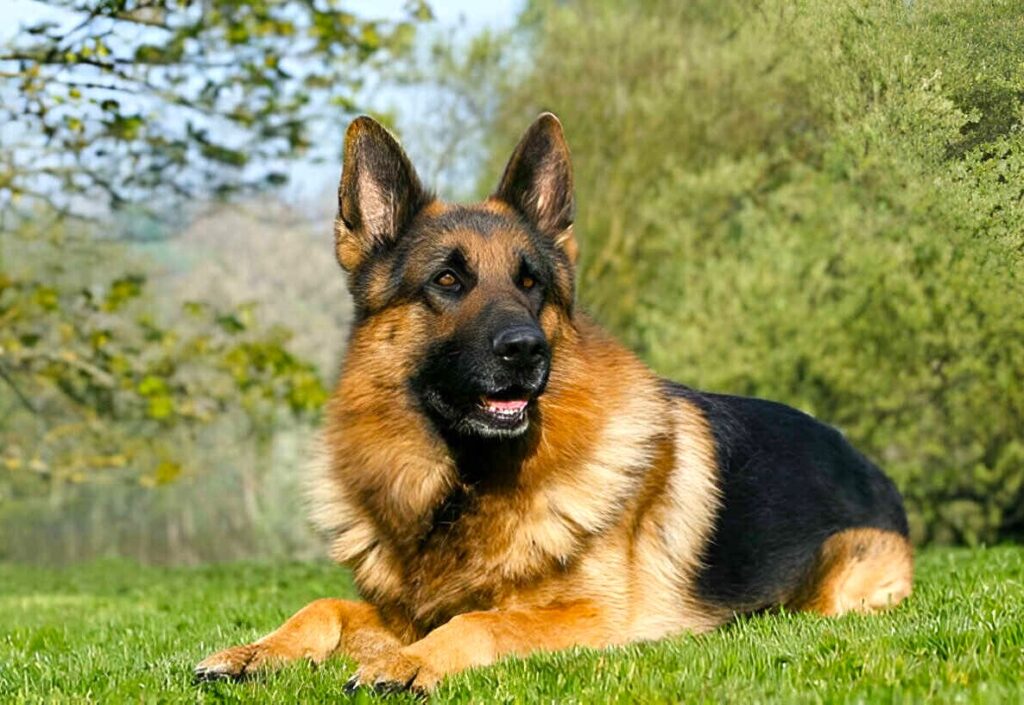
(Photo Credit: slowmotiongli | istock)
The German Shepherd breed’s amazing story started in 1899 and became a defining moment in dog breeding history. These dogs were bred to herd and guard sheep but soon showed their capabilities beyond Germany’s pastures.
Max von Stephanite and the breed’s foundation
Max Emil Friedrich von Stephanitz, who served as a German cavalry officer and studied at Berlin Veterinary College, created what we know as the modern German Shepherd. He spotted Hektor Linksrhein at a dog show in 1899 and was instantly drawn to the dog’s intelligence, loyalty, and beauty. He bought Hektor, gave him a new name – Horand von Grafrath, and created the Verein für Deutsche Schäferhunde (Society for the German Shepherd Dog).
Horand became the lifeblood of von Stephanitz’s breeding program and earned the honor of becoming the first registered German Shepherd Dog. His bloodline thrived through selective breeding with dogs that had ideal traits, particularly through his most successful offspring, Hektor von Schwaben.
From herding dog to versatile worker
German railways started moving sheep across the country, which reduced the need for herding dogs. Von Stephanitz shifted his focus and promoted German Shepherds as police dogs. Their natural intelligence, speed, strength, and sharp sense of smell made them perfect for law enforcement.
Von Stephanitz created detailed testing methods to assess breeding candidates. He focused on:
- Obedience capabilities
- Tracking abilities
- Protection skills
These tests later became the modern IGP (Schutzhund) trials.
German Shepherds in World History
The breed gained worldwide fame after World War I when soldiers returned home with stories about these incredible dogs. Dog stars like Rin Tin Tin and Strongheart helped make the breed popular around the world.
German Shepherds played vital roles during World War II as:
- Message carriers
- Ammunition transporters
- Search and rescue operators
- Facility guards
Post-World War II Germany saw many challenges for the breed. Food shortages and destruction led to the loss of many dogs. Dedicated breeders saved the bloodline through careful selection and breeding programs.
The breed’s name changed during times of anti-German feelings. British people called them “Alsatian Wolf Dogs,” later shortened to “Alsatian.” Dog enthusiasts campaigned until the UK Kennel Club brought back the original name “German Shepherd Dog” in 1977.
German Shepherds today continue their legacy of excellence in many fields, staying true to von Stephanitz’s dream of a versatile, intelligent working breed. Their growth from simple herding dogs to globally respected working companions shows how breeding and adaptability can shape a breed.
Physical Characteristics of the German Shepherd Dog
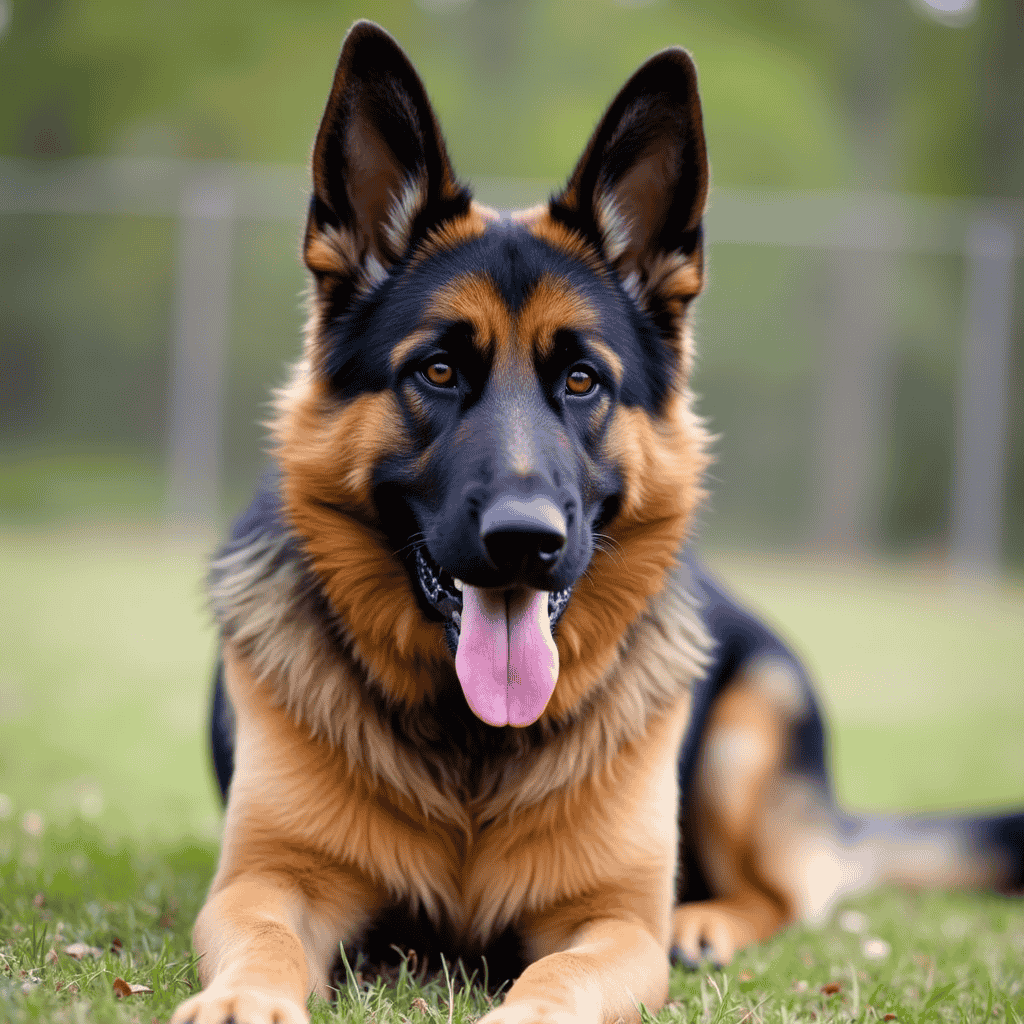
German Shepherds have a perfect mix of strength and grace in their physical build. These medium to large dogs have a well-balanced, muscular body with smooth curves instead of angles that creates a unique silhouette.
Size, weight, and build standards
Male German Shepherds stand between 24-26 inches at the shoulder blade, while females reach 22-24 inches. Males weigh between 75-90 pounds, and females are lighter at 55-70 pounds.
These dogs have unique body proportions. They are longer than tall with an ideal ratio of 10 to 8½. Their muscular frame helps them reach speeds up to 30 miles per hour.
Coat types and colors
German Shepherds come with two main coat types: the double coat and the long, harsh outer coat. Both have a dense undercoat. The double coat has:
- A straight, coarse outer layer close to the body
- A thick, soft undercoat that insulates
Males have thicker, longer fur around their neck compared to other areas. These dogs shed lightly throughout the year with heavy seasonal shedding twice a year during spring and fall.
Tan/black or red/black combinations are the most common colors. Their black masks and body markings range from a classic “saddle” pattern to an overall “blanket” look. Some rare color variations include:
- Pure black
- Sable (multiple colors per hair strand)
- Pure white
- Silver
- Blue
- Liver
- Panda varieties
Distinctive physical traits
The breed’s head has a domed forehead with a long, square-cut muzzle, powerful jaws, and a black nose. Their medium-sized, almond-shaped brown eyes show intelligence and stay alert.
Large, erect ears that stand parallel and point forward are one of their most recognizable features. These ears move back during motion. Their neck raises when excited and lowers while moving quick or stalking.
A bushy tail that reaches the hock completes their balanced look. This well-proportioned body and efficient gait lets German Shepherds cover maximum ground with minimal effort, showing their natural agility and endurance.
German Shepherd Temperament and Personality
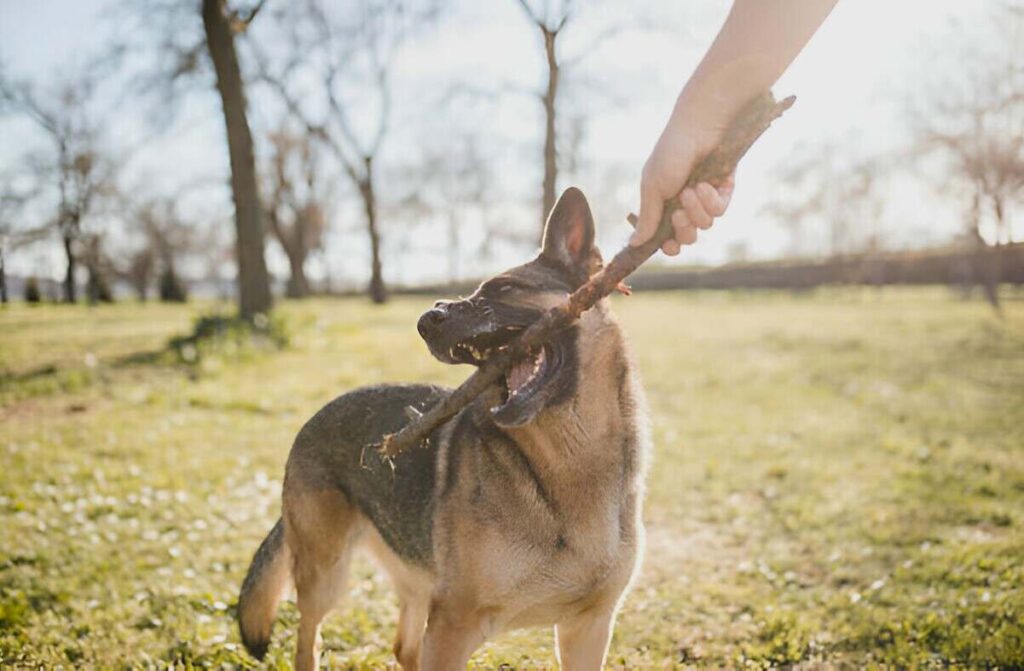
(Photo Credit: DekiArt | istock)
German Shepherds stand out in the canine world with their striking looks and an amazing mix of mental abilities and emotional traits. Research shows these smart dogs have the mental capacity equivalent to a 2.5-year-old human child.
Intelligence and trainability
German Shepherds rank among the top three smartest dog breeds. They learn new commands in less than five repetitions. Their exceptional memory helps them remember commands and tricks, which makes them highly trainable companions. This intelligence comes from their herding background, where quick thinking and alertness helped them manage livestock.
These dogs show mental sharpness beyond simple obedience. They shine at:
- Problem-solving tasks
- Anticipating routines
- Understanding complex instructions
- Adapting to new situations
Loyalty and protective instincts
The breed’s steadfast dedication remains one of their most treasured qualities. German Shepherds build deep bonds with their families and see them as part of their pack. This strong connection shows through:
- Constant companionship
- Strong protective instincts
- Deep devotion to their loved ones
The American Temperament Test Society reports German Shepherds have an impressive 85.3% temperament pass rate. This shows their balanced nature. Their protective traits come from deep-rooted guarding instincts. Proper training keeps these instincts controlled and appropriate.
Social behavior with family and strangers
German Shepherds show remarkable gentleness and affection with their families. They usually create their strongest bond with their main caregiver between 8-16 weeks old. This special connection leads to endearing habits, like following family members everywhere – even into bathrooms. These behaviors stem from their protective nature.
These dogs stay naturally reserved with strangers. This cautious attitude isn’t aggression – it’s just their natural temperament. Good socialization between 12-16 weeks old teaches them to tell real threats from normal social situations.
The German Shepherd Dog Club of America’s studies show most owners describe their dogs as “curious” rather than “fearful” around new people. Their natural caution and intelligence make them great judges of character while staying approachable in the right situations.
German Shepherds take 2-3 years to reach full emotional maturity. They keep their eagerness to please their owners throughout development and thrive on meaningful tasks that enrich their lives. This blend of intelligence, loyalty, and balanced temperament explains why they excel in roles from family companion to working dog.
Working Roles and Capabilities

German Shepherds excel in a variety of working roles, from military operations to search and rescue missions. These amazing dogs have made themselves essential in many professional fields. Their outstanding capabilities have earned them worldwide recognition.
Police and Military Service
German Shepherds became the preferred military working dogs by 1910. These dedicated canines played vital roles as messengers, ammunition carriers, and facility guards throughout World War II. Their service continued through the Vietnam War, where more than 9,000 handlers worked alongside 4,000 dogs.
Today, about 600 military dog teams serve actively in various operations. These teams show remarkable capabilities:
- They perform HALO (High Altitude Low Opening) jumps with Special Operators
- They conduct boat insertions with Navy SEAL teams
- They detect explosives and narcotics
- They patrol troubled areas
The breed’s success in law enforcement comes from exceptional traits, especially their defense drive and knowing how to hunt. These qualities, combined with their physical strength and stamina, make them excellent patrol partners and specialists in catching criminals.
Search and rescue operations
Search and rescue (SAR) German Shepherds need specialized training in several disciplines. They can:
- Follow footsteps with precision in ground tracking
- Detect human scent carried by wind
- Work in collapsed buildings and earthquake zones
- Find subjects in water environments
These dogs thrive in challenging conditions and maintain exceptional endurance and focus. They achieve consistently high success rates in search operations because they work well whatever the distractions.
Service and assistance roles
German Shepherds have led the way as service dogs, especially as guides for the visually impaired. They were once the only breed chosen for this purpose. Their success in service work comes from several key traits:
Their size makes them perfect for mobility support tasks. They also have the intelligence to handle complex assistance duties, from helping wheelchair users to supporting people with psychiatric needs.
The sort of thing I love is a study comparing German Shepherds with Labrador Retrievers. The study showed interesting differences in temperament. Labradors scored higher in emotional stability and friendliness, while German Shepherds showed better defensive behavior and controlled aggression. These findings helped match each breed’s natural strengths to specific roles.
German Shepherds continue their service in various assistance roles today, though their numbers have changed. To name just one example, by 2013, they made up about 15% of dogs trained by Guide Dogs of America. Their adaptability and work ethic keep them valuable in service roles, even as breed priorities change in certain specialized areas.
Health Considerations for German Shepherds
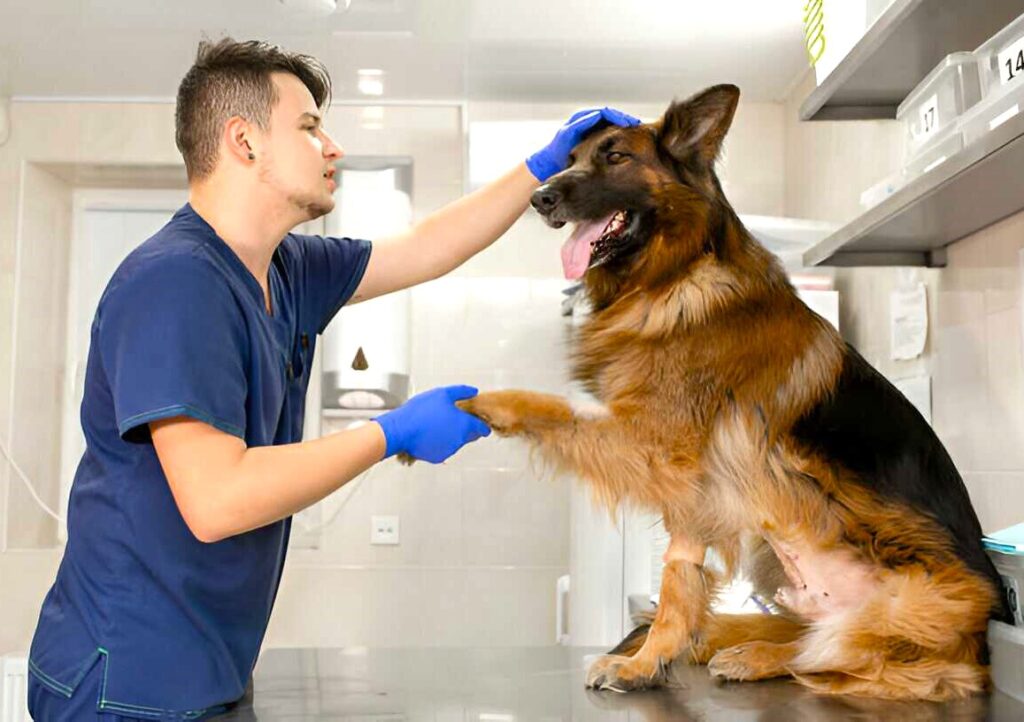
(Photo Credit: Kateryna Kukota | istock)
German Shepherds look tough, but these dogs face several inherited health challenges that need careful attention from their owners. Knowing these conditions helps owners spot problems early and manage them better to give their dogs a good life.
Common genetic conditions
Degenerative Myelopathy (DM) is one of the most important genetic concerns 14. It causes gradual weakness in hind limbs and can lead to complete paralysis. Genetic testing shows the test is clear, while 29.1% are carriers, and 3.9% risk developing DM.
We found that Exocrine Pancreatic Insufficiency (EPI) affects German Shepherds under age 2. It causes severe malnutrition even when dogs eat regularly. The condition starts with selective atrophy of pancreatic acinar cells, which leads to insufficient digestive enzyme production.
Joint and mobility issues
About 20.6% of evaluated German Shepherds have hip dysplasia. The condition develops when a dog’s hip joint doesn’t form properly, which causes:
- Progressive joint deterioration
- Chronic pain
- Reduced mobility
Elbow dysplasia affects 18.8% of the breed. Both conditions need regular vet monitoring and might need surgery in severe cases.
Preventative care and screening
The German Shepherd Dog Club suggests several vital health evaluations:
- Hip and elbow dysplasia screening through OFA evaluation
- Cardiac and thyroid testing
- Regular temperament assessments
A dog’s weight is vital since studies show overweight puppies risk developing joint problems more often. Early vet check-ups should focus on:
- Joint health assessment
- Genetic condition screening
- Digestive system monitoring
Research shows 63.43% of German Shepherds develop at least one health disorder in their lifetime. A detailed preventive care routine is essential. Good nutrition, regular exercise, and weight management can minimize these health risks.
Exercise and Training Requirements
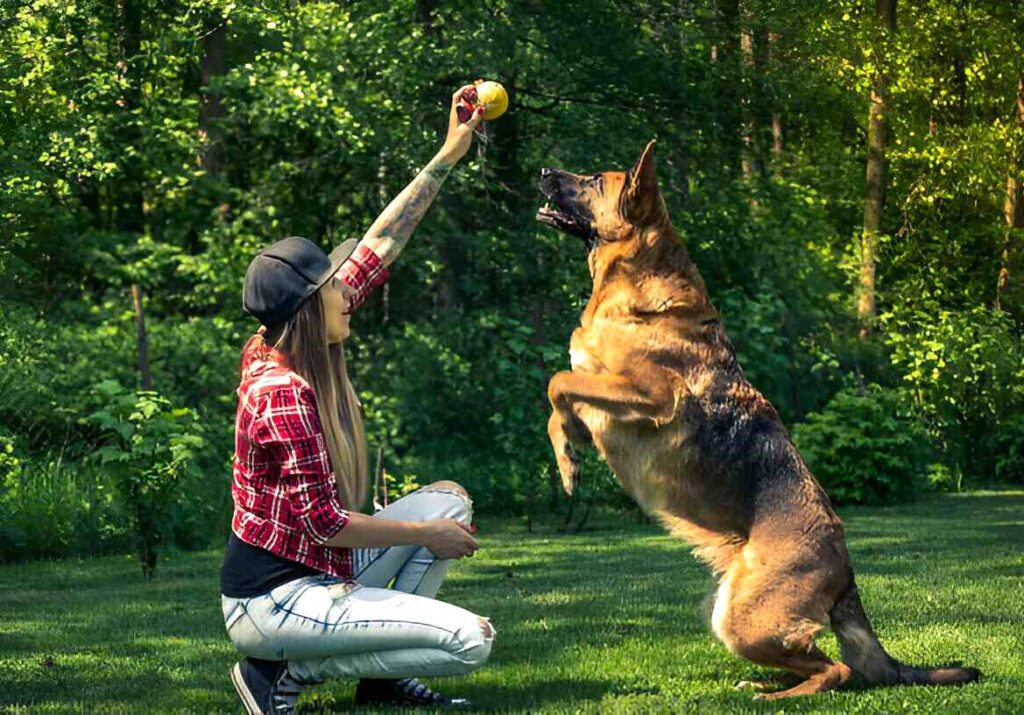
(Photo Credit: merc67 | istock)
German Shepherds need consistent dedication to meet their physical and mental needs. These high-energy dogs do best with well-laid-out exercise routines and engaging mental activities that maintain their well-being.
Daily physical needs
German Shepherds need more exercise than most other breeds. They just need at least 90 minutes of daily physical activity. These active dogs benefit from two hours of exercise spread throughout the day to stay healthy. This routine helps avoid behavioral problems that often come from unused energy.
Physical activities should include:
- Brisk walks at a 4mph pace
- Swimming sessions for full-body workouts
- Agility training to boost coordination
- Fetch games that satisfy their prey drive
Age determines exercise requirements. Puppies need careful activity management based on the five-minute rule – five minutes of formal exercise per month of age. This measured approach protects developing joints from too much strain.
Mental stimulation importance
Mental exercises tire German Shepherds more than physical activities alone. These smart dogs need daily brain games to stay mentally sharp and avoid destructive behaviors.
Brain stimulation works because German Shepherds were originally bred to work, but most modern companions lack traditional jobs. These dogs might show:
- Excessive chewing
- Persistent barking
- Destructive digging
- Hyperactive behavior
Research shows mental stimulation releases dopamine, the ‘happy’ brain chemical, while lowering heart rate and stress levels. Brain-boosting activities that work include:
- Hide-and-seek games using their superior scenting abilities (225 scent receptors)
- Puzzle toys with hidden treats
- Obedience training sessions lasting 5-15 minutes
- Nose work exercises for tracking and searching
Physical exercise combined with mental challenges creates the most effective routine. This combination helps regulate emotions, sharpens focus, and deepens their commitment to their owner. Daily walks become more engaging when routes change and include training elements.
Living With a German Shepherd
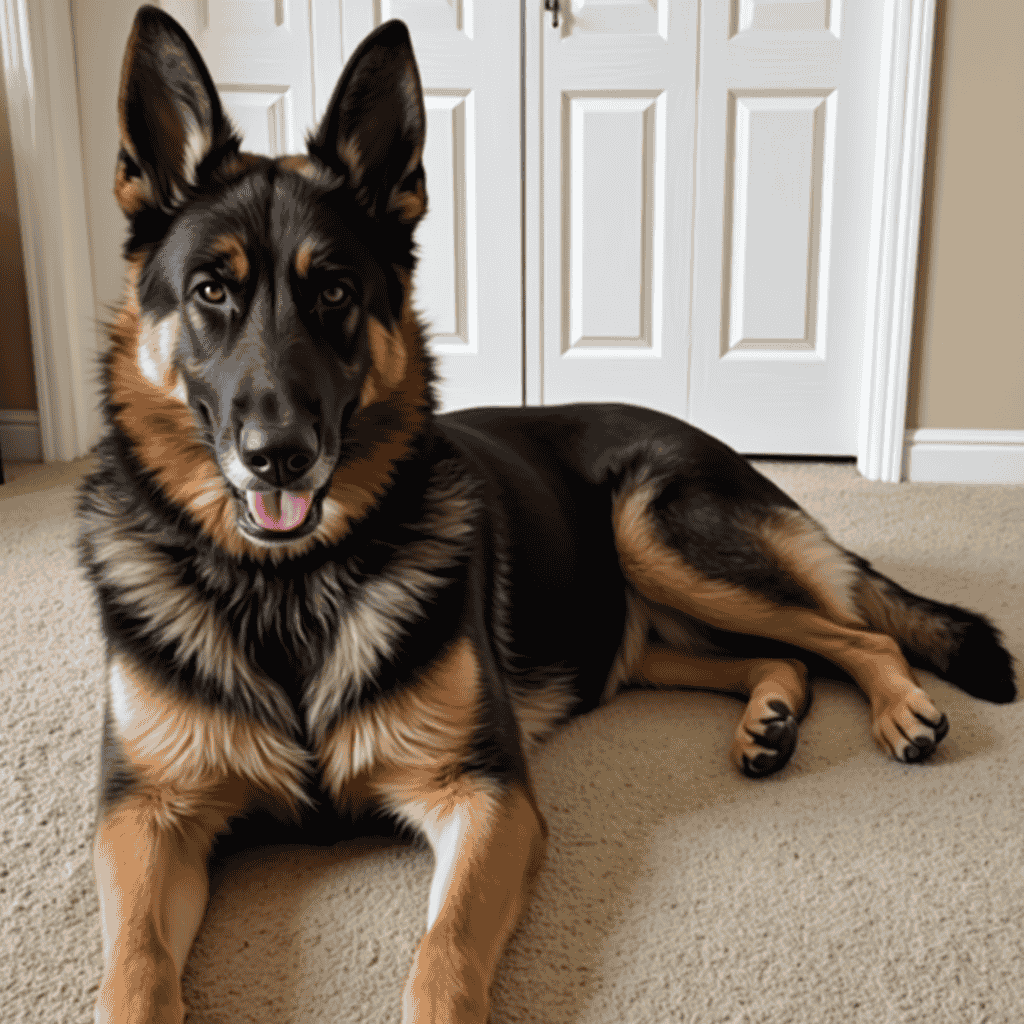
Getting a German Shepherd requires careful planning and dedication. These smart, energetic dogs need specific living conditions. Your full attention helps them become wonderful family companions.
Space and environment considerations
Your German Shepherd needs enough space to move freely. The size of your home isn’t as crucial as how you use it. A fenced area of at least 1000 square feet (20′ x 50′) gives your dog a safe space to exercise and play outdoors. Athletic German Shepherds can jump over short fences, so barriers should be at least 5 feet tall.
Indoor living arrangements should include:
- A designated sleeping area
- Space for food and water stations
- Room for interactive play
- A quiet retreat spot
Family Compatibility
German Shepherds build strong bonds with their families between 8-16 weeks of age. These loyal dogs fit well into family life, but there are things to keep in mind. Female German Shepherds tend to be gentler with children. Males might not handle rough play as well.
You must watch young children around these powerful dogs. Teaching kids how to behave around German Shepherds prevents problems. Key rules include:
- No pulling ears or tail
- Respecting meal times
- Avoid startling the dog
- Never attempting to ride the dog
Time and attention are needed
German Shepherds need lots of time with their owners. They shouldn’t be alone for more than four hours. Long periods of solitude can cause anxiety and destructive behavior.
Daily routines should include:
- Regular exercise sessions
- Training periods
- Social interaction
- Mental stimulation through games and tasks
German Shepherds might develop bad habits if they don’t get enough exercise. These intelligent dogs thrive when they have meaningful tasks and regular family interaction.
German Shepherds see themselves as true family members. This deep connection means they should be part of daily household activities instead of living outside. Their strong bond creates meaningful relationships, but you need to stay committed to their physical and emotional needs.
Grooming and Care Essentials
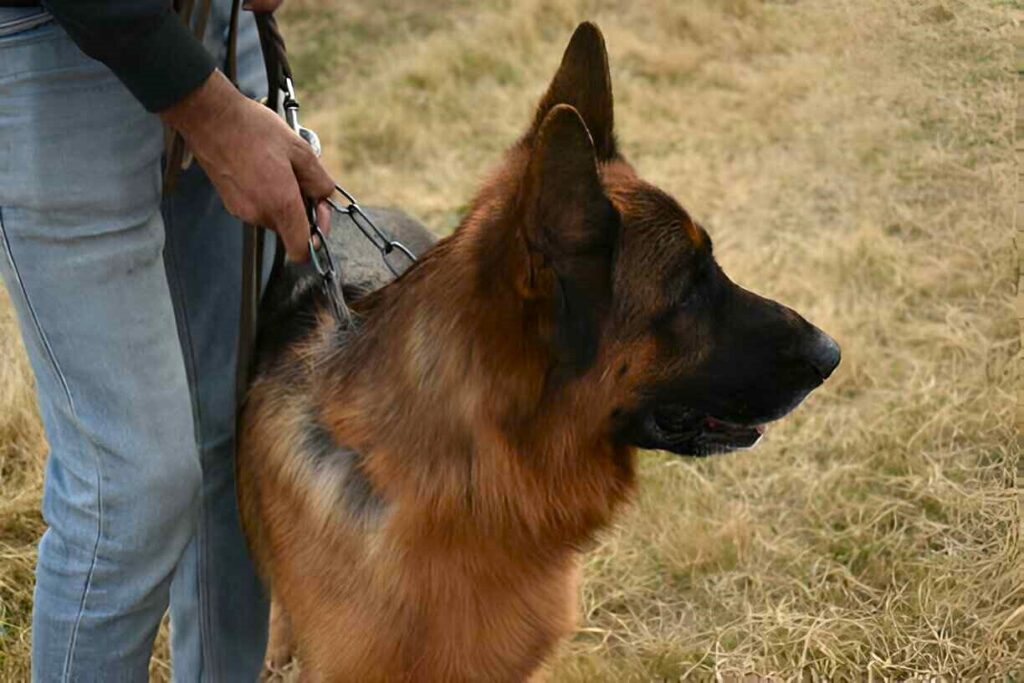
(Photo Credit: Bahadur Ali | istock)
Your German Shepherd’s magnificent double coat needs regular grooming to stay healthy. These dogs shed year-round, and heavy shedding happens twice a year during spring and fall.
Managing shedding and coat care
Regular brushing is the lifeblood of German Shepherd grooming. You’ll need to brush your dog 3-4 times weekly to remove loose fur and keep their coat healthy. The best results come from using a slicker brush in the coat’s natural direction, starting at the neck and working your way to the tail.
You’ll need these grooming tools:
- A slicker brush to maintain daily care
- An undercoat rake to manage the thick undercoat
- A deshedding tool for weekly deep grooming
Bathing and skin health
In stark contrast to what many believe, German Shepherds only need baths every few months. Too much bathing removes their coat’s natural oils and can lead to dry, irritated skin. Here’s what you should think about when it’s bath time:
- Pick gentle, dog-specific shampoos that keep natural oils intact
- Use deep-cleaning products if your dog loves outdoor activities
- Try medicated shampoos for dogs with sensitive skin
The double coat naturally regulates body temperature. You should never shave a German Shepherd unless medically required. Their coat’s natural growth cycle can take up to two years to return to normal after shaving.
Nail, ear, and dental maintenance
Good grooming includes everything in coat care. Your dog needs regular nail trimming to avoid discomfort and possible paw injuries. Professional-grade clippers or grinders work best to keep nails at the right length.
German Shepherds’ distinctive upright ears need extra attention because they can easily get infected. Clean them gently with proper wipes to prevent problems. Look for infection signs and get veterinary help quickly if you notice anything unusual.
Dental care significantly impacts your dog’s overall health. Brushing their teeth regularly with dog-specific toothpaste helps prevent plaque and gum disease. Starting a dental care routine early helps keep their mouth healthy throughout their life.
German Shepherds as Family Dogs
A German Shepherd brings joy and responsibility to your family. These loyal dogs blend perfectly into family life and build strong connections with everyone at home.
Key Family Compatibility Traits:
| Aspect | Rating |
| Child Friendliness | High with training |
| Pet Compatibility | Moderate |
| Family Bonding | Excellent |
| Supervision Needs | Consistent |
| Training Success | 95% |
Compatibility with children
German Shepherds show amazing patience with kids, particularly when they grow up together from puppy age. Their protective nature makes them excellent guardians, but proper training remains vital for safe interactions.
Parents should think over these points before getting a German Shepherd:
- Puppies need extra patience while they learn proper play behaviors
- Growing puppies might accidentally scratch during playtime
- Kids’ mixed commands can slow down training progress
Watching over your dog and children is a vital part of success. Even the best-trained German Shepherds need supervision around kids – not because they might be aggressive, but to avoid accidental bumps during excited play.
Interaction with other pets
German Shepherds get along differently with other animals based on their early social experiences. These smart dogs can become best friends with other pets if you introduce them the right way.
Your multi-pet home needs good planning:
- Take away toys and food before new pet introductions
- Give each animal its own space
- Plan 3-6 months for complete family bonding
The first meeting matters by a lot in pet introductions. Baby gates help create positive experiences between German Shepherds and other pets. On top of that, separate feeding areas stop food-guarding behavior.
German Shepherds hate being alone and don’t do well without people or animal friends. Their social personality makes them great fits for homes with multiple pets, if they learn social skills early.
These dogs often build special bonds with different family pets. Some German Shepherds show deep emotional connections – there are cases where they grieved for long periods after losing their animal friends.
Choosing Your German Shepherd Puppy
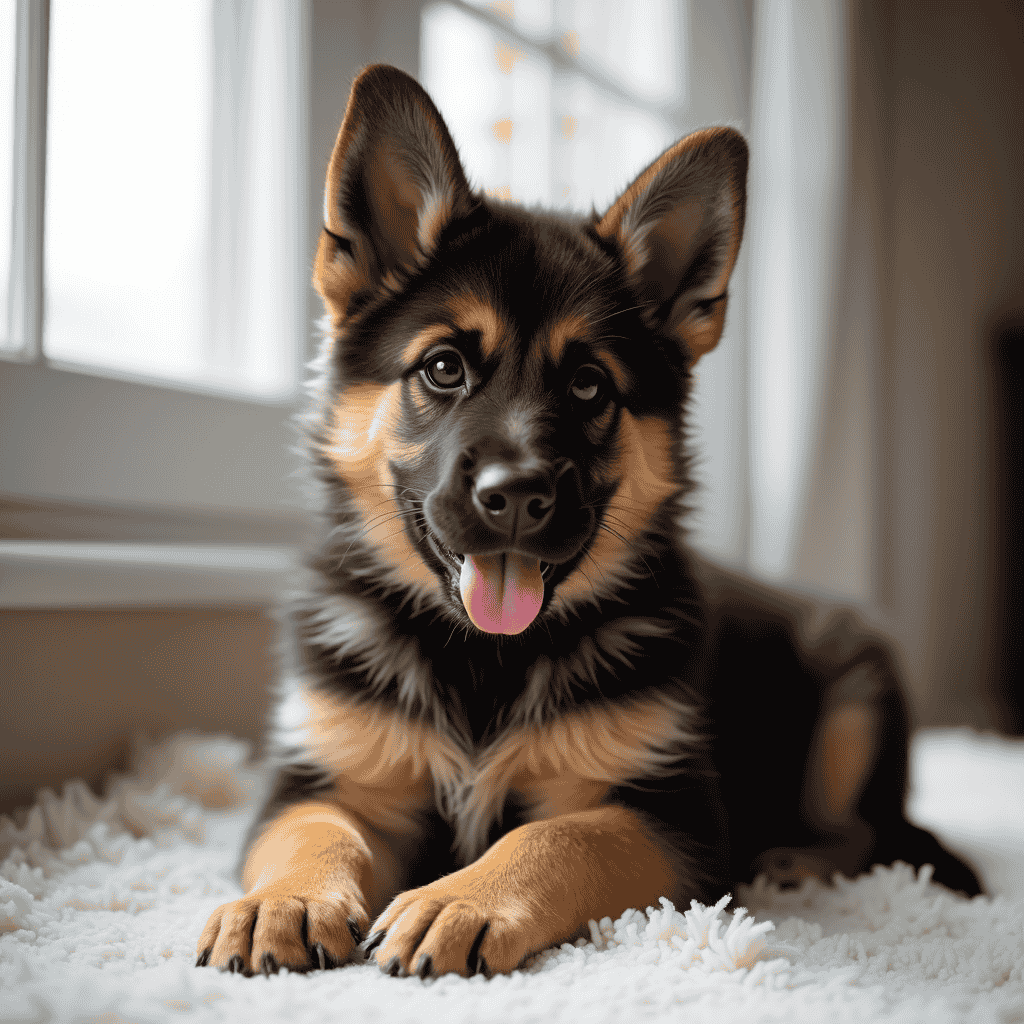
Choosing the right German Shepherd puppy means looking at their family history, health tests, and personality. The right choice now will give you a perfect companion that fits your lifestyle for years to come.
Working line vs. show line considerations
Working line German Shepherds have higher energy levels, sharper instincts, and stronger work drives. These dogs shine in demanding roles but they just need constant activity to avoid destructive behaviors. Show lines are calmer and make better family pets.
Main differences between the lines are:
- Working lines: Stronger build, various coat colors, intense drive
- Show lines: Black and red coloring, milder temperament, less exercise needs
Health clearances to look for
Good breeders focus on genetic testing and health screenings. The most important health certificates you should check are:
- Hip and elbow x-rays checked by OFA or SV certification bodies
- DNA testing to check for Degenerative Myelopathy (DM)
- Full vet records showing vaccinations and treatments
Research shows hip dysplasia affects about 20% of German Shepherds. You should verify both parent dogs have passed hip tests with scores that show healthy joints.
Temperament evaluation in puppies
Watch how puppies behave between 7½ to 8 weeks old. Look for pups that walk up to you confidently and show curiosity instead of fear. Stay away from puppies that guard their food or seem too shy, as these behaviors often stay with them into adulthood.
Quality breeders usually:
- Focus only on German Shepherds
- Put time into early socialization
- Let puppies spend lots of time with people
- Give puppies their own space after 8 weeks
Visit multiple times to see if the puppy’s behavior stays consistent. Note that puppies who reach 12 weeks without proper socialization might have trouble adjusting later. Your lifestyle, experience, and plans for the dog will help you decide between working and show lines.
Conclusion
German Shepherds rank among the most amazing dog breeds. Their mix of smarts, loyalty, and adaptability sets them apart. You can pick from types of German Shepherds like working lines or show lines. These dogs show steadfast dedication and amazing skills as companions.
These incredible dogs need plenty of exercise, training, and grooming time. Their loyalty makes all the hard work worth it. Your German Shepherd’s protective nature and deep family connection build strong bonds based on trust and understanding.
Of course, you need to watch out for health issues, especially when you have concerns about joints and genetic conditions. Good vet care, the right food, and enough exercise help your German Shepherd live a healthy life that meets their needs.
A happy German Shepherd matches your energy level and work style. Well-trained and socialized German Shepherds shine not just as family pets but as working partners in any discipline. They truly deserve their spot as one of the world’s most capable and loved dog breeds.
Frequently Asked Questions About German Shepherds
Q1. What are the key physical traits of a German Shepherd?
German Shepherds are medium to large dogs, standing 22-26 inches tall and weighing 50-90 pounds. They have a distinctive double coat, erect ears, and a muscular build. Their coloring is typically black and tan, though other variations exist.
Q2. How much exercise does a German Shepherd need?
German Shepherds require at least 90 minutes of daily exercise, ideally spread across two hours. This should include a mix of physical activities like brisk walks, swimming, or fetch, as well as mental stimulation through training and puzzle toys.
Q3. Are German Shepherds good family dogs?
Yes, when properly trained and socialized, German Shepherds can make excellent family companions. They are loyal, protective, and generally good with children. However, they require consistent training, exercise, and attention to thrive in a family environment.
Q4. What health issues are common in German Shepherds?
Common health concerns for German Shepherds include hip and elbow dysplasia, degenerative myelopathy, and exocrine pancreatic insufficiency. Regular veterinary check-ups, genetic testing, and maintaining a healthy weight can help manage these risks.
Q5. How intelligent are German Shepherds?
German Shepherds are highly intelligent, ranking as the third-smartest dog breed. They can learn new commands in fewer than five repetitions and excel in various working roles, from police and military work to search and rescue operations.
